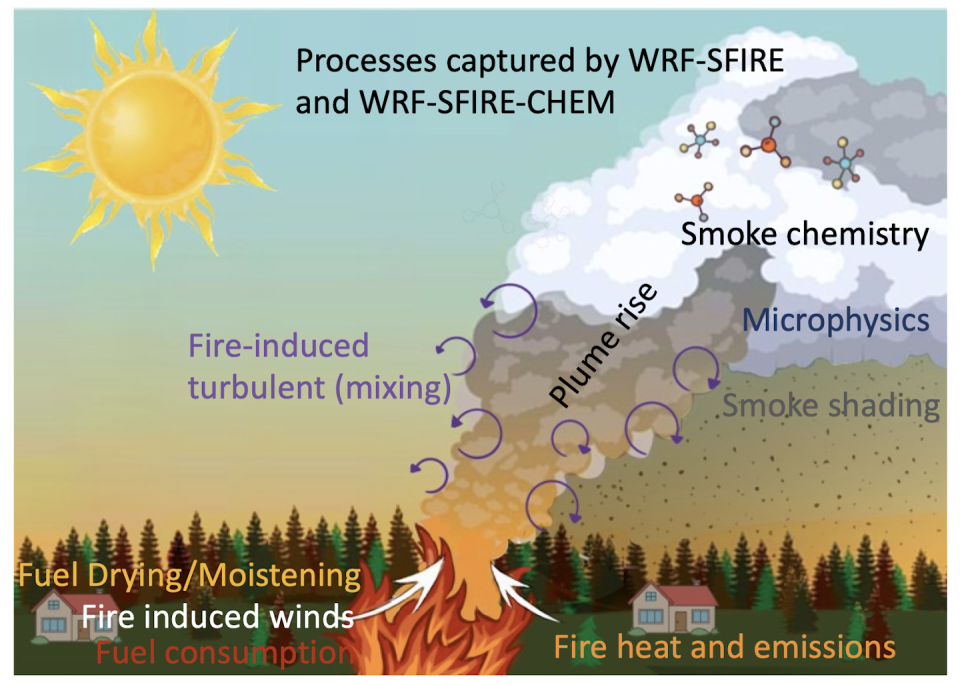Wildfires, fire vortices, towering thunderstorms: When fires grow large and hot enough, they can create their own weather conditions.
In such extreme fire situations, the usual methods used by firefighters to directly control the fire do not work and the wildfires rage out of control.
So how can a fire create weather?
I’m an atmospheric scientist who uses data collected by satellites in weather forecasting models to better predict extreme fire weather events. Satellite data shows that fire storms are much more common than anyone realized a few years ago. Here’s what’s happening.
Wildfire and weather connections
Picture a wilderness scene filled with dry grass, brush, and trees. A spark, perhaps from lightning or a tree branch hitting a power line, falls. If the weather is hot, dry, and windy, that spark can quickly start a forest fire.
When vegetation burns, a large amount of heat is released. This warms the air near the ground, and this air rises like a hot air balloon because hot air is less dense than cold air. Cooler air then rushes in to fill the space left by the rising air.
This is how wildfires create their own wind patterns.

What happens next depends on the stability of the atmosphere. If the temperature drops rapidly as you rise above the ground, the rising air will always be warmer than its surroundings and will continue to rise. If it rises high enough, the moisture will condense to form a cloud known as pyrocumulus or flammagenitus.
If the air continues to rise, at some point the condensed moisture will freeze.
When a cloud contains both liquid and frozen water particles, collisions between these particles can lead to electric charge separation. If the charge buildup is large enough, an electric discharge—better known as lightning—occurs to neutralize the charges.
Whether a fire cloud develops into a storm depends on three key components: buoyancy source, instability, and moisture.
Dry lightning
Wildfire environments often have limited moisture. When conditions in the lower atmosphere are dry, this can lead to what is known as dry lightning.
No one living in a wildfire-prone environment wants to see dry lightning. This is when a storm produces lightning but the precipitation evaporates before it reaches the ground. This means there is no rain to help put out fires triggered by lightning.
Fire Vortexes
As air rises through the atmosphere, it may encounter different wind speeds and directions, a phenomenon called wind shear. This can cause the air to spin. The rising air can make the spin vertical, similar to a hurricane.
These fire vortices can have strong winds that can spread flaming ash and create new fire areas, but they are not usually true tornadoes because they are not associated with rotating thunderstorms.
Decaying storms
Eventually, the thunderstorms triggered by the wildfire will begin to die down, and what went up will come down. The downwash of the decaying thunderstorm can create erratic winds on the ground, further spreading the fire in unpredictable directions.
When fires create their own weather conditions, their behavior can become more unpredictable and erratic, further increasing the threat to residents and firefighters fighting the fire. Anticipating changes in fire behavior is important for everyone’s safety.
Satellites show wildfire-related weather events aren’t that rare
Meteorologists first noticed the fires’ ability to create storms in the late 1990s, but it wasn’t until the 2017 launch of the GOES-R Series satellites that scientists obtained the high-resolution images needed to see that fire-related weather was actually commonplace.
Today, these satellites can alert firefighters to a new fire even before they have to call 911. This is important because there is an increasing trend in the number, size and frequency of wildfires in the United States.


Climate change and increasing fire risks
The risk of heatwaves and droughts is increasing in North America, as rising global temperatures make dry landscapes and forests ripe for burning. Climate model experiments suggest that human-caused climate change will continue to increase this risk.
As more people move into fire-prone areas in this warming climate, the risk of fires increases. With fires come knock-on hazards, such as burn-scarred landscapes that persist long after the fires are extinguished and are much more susceptible to landslides and debris flows that can impact water quality and ecosystems.
Communities can reduce their vulnerability to fire damage by building defensible spaces and firebreaks and making homes and property less vulnerable. Firefighters can also reduce fuel loads on surrounding areas through controlled burning.
It is important to remember that fire is a natural part of the Earth system. As fire scientist Stephen J. Pyne has written, we humans must reorient our relationship with fire so that we can learn to live with it.
This article is republished from The Conversation, a nonprofit, independent news organization that brings you facts and trusted analysis to help you understand our complex world. By Kyle Hilburn Colorado State University
Read more:
Kyle Hilburn receives funding from the National Oceanic and Atmospheric Administration and the National Aeronautics and Space Administration.